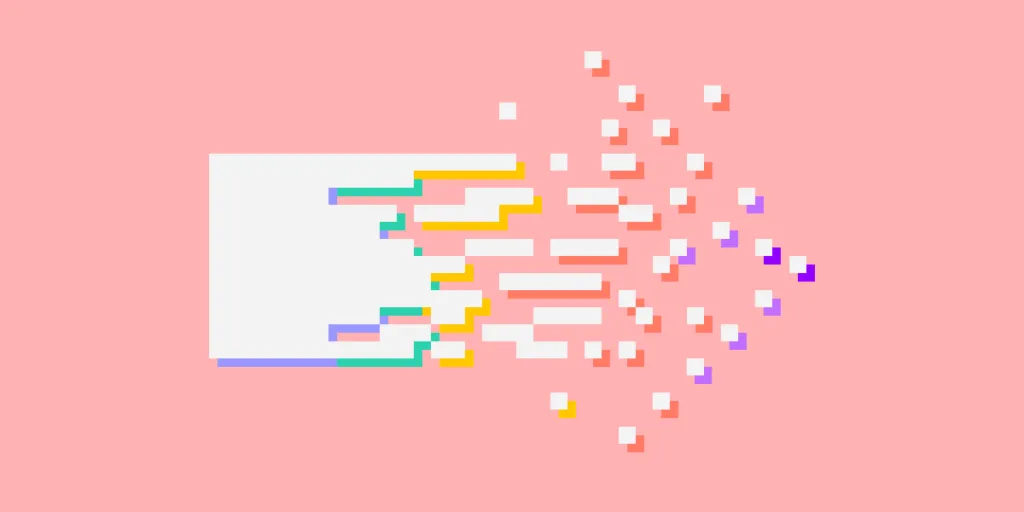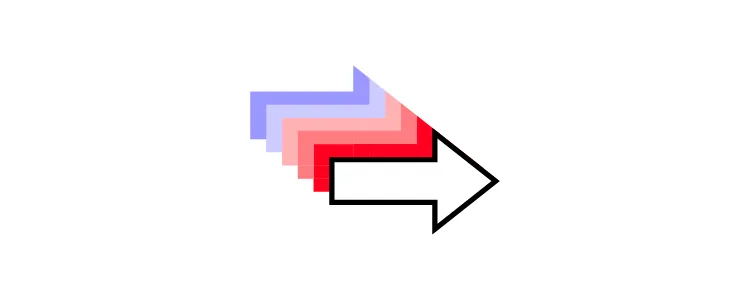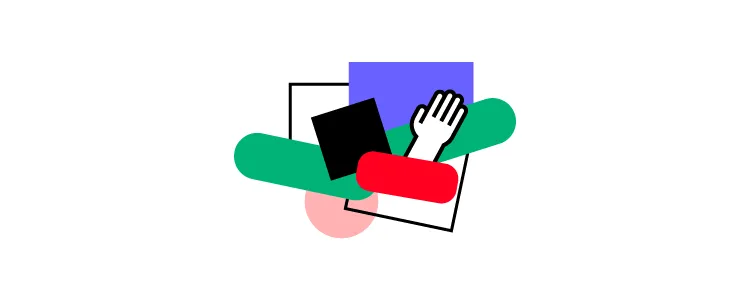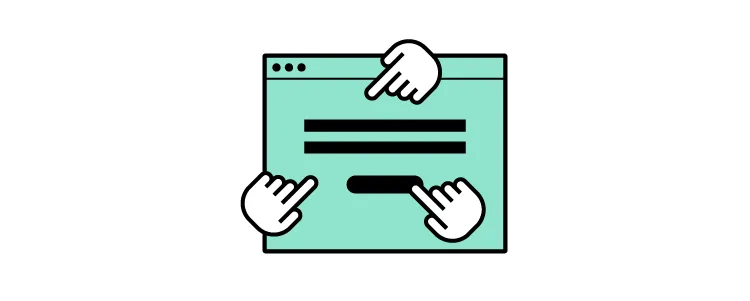What is Throwaway Prototyping?

Throwaway prototyping is a software development approach that involves rapid creation of a prototype with the understanding that it will be discarded after use. The primary goal of throwaway prototyping is to provide a tangible representation of the app functionality early in the development process, allowing stakeholders to visualize and interact with the proposed system.
This approach is particularly useful in agile projects where teams still trying to conceptualize initial requirements and specifications, or where frequent feedback is crucial. However, it may not be suitable for all types of product development, especially those with strict regulatory or documentation requirements.
Throwaway prototyping can take a form of a paper prototype, wireframe or working model of a product — it all depends on the tools you use. UXPin Merge is a perfect tool for throwaway prototyping model, because it allows you to build a prototype that resembles a final product in one day or less. With built-in templates, patterns, and fully coded components, you can assemble a prototype on the spot. Try UXPin Merge.
What is Throwaway Prototyping?
Throwaway prototyping is a way of making a fast and cost-effective model of app user interface and its features. Its key characteristic is that this prototype is not intended to being passed to the development phase. Instead, it serves as a learning tool to enhance communication between designers, developers, and stakeholders, clarify requirements, and identify potential design flaws early in the development cycle.
Once the prototype has fulfilled its purpose, it is set aside, and the team moves on to a more structured prototype development with multiple stages of iterations and tests with end users.
This type of prototyping is frequently contrasted with evolutionary prototyping. Throwaway prototyping and evolutionary prototyping are two distinct approaches in the prototyping spectrum, and they are often placed against one another due to their different objectives and methodologies.
Evolutionary prototyping assumes a more stable understanding of requirements. The aim is to build a prototype that evolves into the final product. The prototype is incrementally refined based on user feedback, ultimately becoming the complete system with an utmost care to user experience.
Is a Throwaway Prototype Still Relevant in 2024?

Throwaway prototyping is relevant in certain scenarios within the software development process. Here are some situations where a throwaway prototype might be particularly useful:
- Dealing with uncertain requirements — when initial requirements are not well-defined or are expected to change during the development process, a throwaway prototype can help quickly explore and refine those requirements.
- Getting stakeholders involved — for web development or app development projects where early stakeholder feedback is crucial, a throwaway prototype allows stakeholders to visualize and interact with a tangible representation of the final product, facilitating better communication and understanding.
- Reducing risk of misunderstandings — if there is a risk of misinterpretation or misinterpreting requirements, a throwaway prototype can serve as an ideation device, helping clarify expectations and avoid compromising project success.
- Delivering proof of concept — when there’s a need to test the feasibility of a concept or technology, a throwaway prototype allows for a quick proof of concept without the commitment of developing the entire system.
- Managing time and budget constraints — in projects with tight timeframes or limited budgets, throwaway prototyping provides a cost-effective way to gather early feedback and make necessary adjustments before committing to full-scale development.
- Enhancing communication — for projects involving diverse stakeholders with varying technical backgrounds, a throwaway prototype can serve as a common visual representation that aids communication and aligns expectations.
While this approach to software prototyping has its advantages in these situations, it’s essential to recognize that it might not be the best fit for all projects.
Key Problems with the Throwaway Prototype Approach

This form of rapid prototyping isn’t beneficial to the projects with complex approval cycles and strict regulatory compliance.
In industries with strict regulatory requirements, where thorough documentation and traceability are essential, throwaway prototyping may not align with the need for comprehensive documentation and formal processes.
Whereas, in projects where obtaining approvals involves a complex and lengthy process, throwaway prototyping may introduce challenges.
The rapid development and discarding of prototypes may not align well with extended approval cycles, potentially leading to delays and inefficiencies in the project timeline. A more structured form of project management may require design and development teams to build an actual prototype that will serve as a UX deliverable and accommodate the necessary approval procedures.
Advice on Creating a Rapid Throwaway Prototype

The success of a throwaway prototype lies in its ability to gather valuable information efficiently, improve the overall understanding of the project, and rapidly explore ideas. How to do that? Here are key pieces of advice that come in handy for anyone who creates a rapid throwaway prototype.
Communicate the purpose
Clearly communicate to all stakeholders the purpose of creating a throwaway prototype. Emphasize that the throwaway prototype is not intended to become the final product. It is a tool designed for exploration, learning, and refinement. This distinction is important to prevent any misconception that the prototype is the actual product in progress.
Highlight that the throwaway prototype enables quick mock-up of the final system, and thus, it is open to iterations. It’s a flexible and adaptable approach that allows for rapid adjustments based on feedback, ultimately leading to a better understanding of initial requirements.
When stakeholders understand the purpose of the throwaway prototype, their expectations align with the intended outcomes. This reduces the likelihood of disappointment or confusion regarding the role of the prototype in the overall project.
Clear communication encourages active participation from stakeholders. When they know that the prototype is a tool for collaboration and refinement, they are more likely to engage proactively in the feedback and evaluation process.
Involve stakeholders from the start
Bring stakeholders into the process from the initial stages of prototype development. Early involvement ensures that their perspectives are considered in the conceptualization and design phases, reducing the likelihood of misalignment in the later stages of project life cycle.
Moreover, involving decision-makers early ensures that the end product meets their expectations. It is also crucial for project approvals, resource allocation, and overall project direction.
Discovering discrepancies or issues late in the development process can be costly and time-consuming. Involving stakeholders in this type of prototyping helps catch and address concerns before extensive development work has been completed, reducing the risk of late-stage changes or miscommunication.
Take design risks
Taking design risks in throwaway prototyping can be a powerful strategy for innovation and refinement, ultimately contributing to the development of a more effective and user-centered final product.
Throwaway prototyping provides a low-risk environment for experimenting with creative and innovative design concepts. The team can push boundaries, explore new ideas, and test unconventional approaches without the fear of impacting the final product.
Since the throwaway prototype is not intended to evolve into the final product, it allows for rapid iteration and adjustment of design elements. Design risks can be taken, and based on feedback, the prototype can be quickly modified to explore alternative approaches.
The freedom to take risks early in the software engineering process helps spot potential issues or challenges with innovative ideas, identifying and addressing them before significant resources are invested in full-scale development. This proactive approach minimizes the risk of discovering problems late in the project.
Embrace interactive prototyping
It’s often said that throwaway prototyping should be done as a sketch on paper or a basic wireframe, but we’re here to propose something different. Design tools evolved so much that you can add functionality to your prototype without wasting resources, such as money and time.
A functional prototype provides clarity on how the proposed idea will work in practice. It helps in addressing uncertainties and ensuring that everyone involved in the project has a shared understanding of the concept.
With UXPin Merge, you don’t start with a blank canvas. The tool gives you fully interactive coded components that you can arrange on the canvas to quickly explore your design idea. Check out how quickly yoou can build a dashboard design with it.
Seek feedback actively
The throwaway prototype is a communication tool to align everyone’s understanding of the project. Establish open communication channels for feedback. Provide multiple avenues, such as surveys, interviews, or dedicated feedback sessions, to make it convenient for stakeholders and users to share their thoughts on the prototype.
Actively seeking feedback is not a one-time activity but an ongoing process throughout the prototyping and development phases. This mindset fosters a culture of adaptability and responsiveness.
Create a Throwaway Prototype with UXPin Merge
Throwaway prototypes are useful when you want to align your team on the requirements for the product you are creating. It helps to find team agreement, explore possibilities, and find an innovative solution while saving costs and time. One of the best tools for this and other kind of prototyping is UXPin Merge. It has templates, patterns, and built-in component libraries that makes prototyping process intuitive. Explore design ideas in a friendly environment. Try UXPin Merge.




